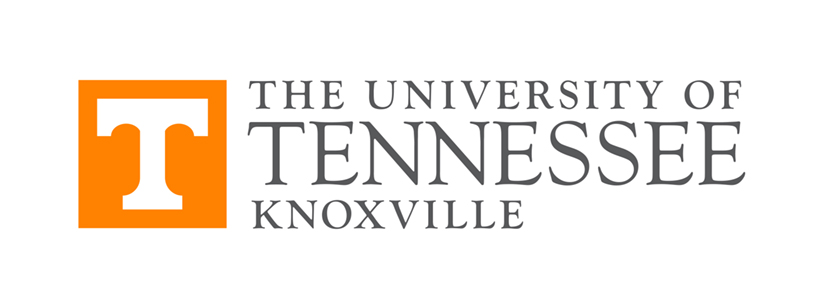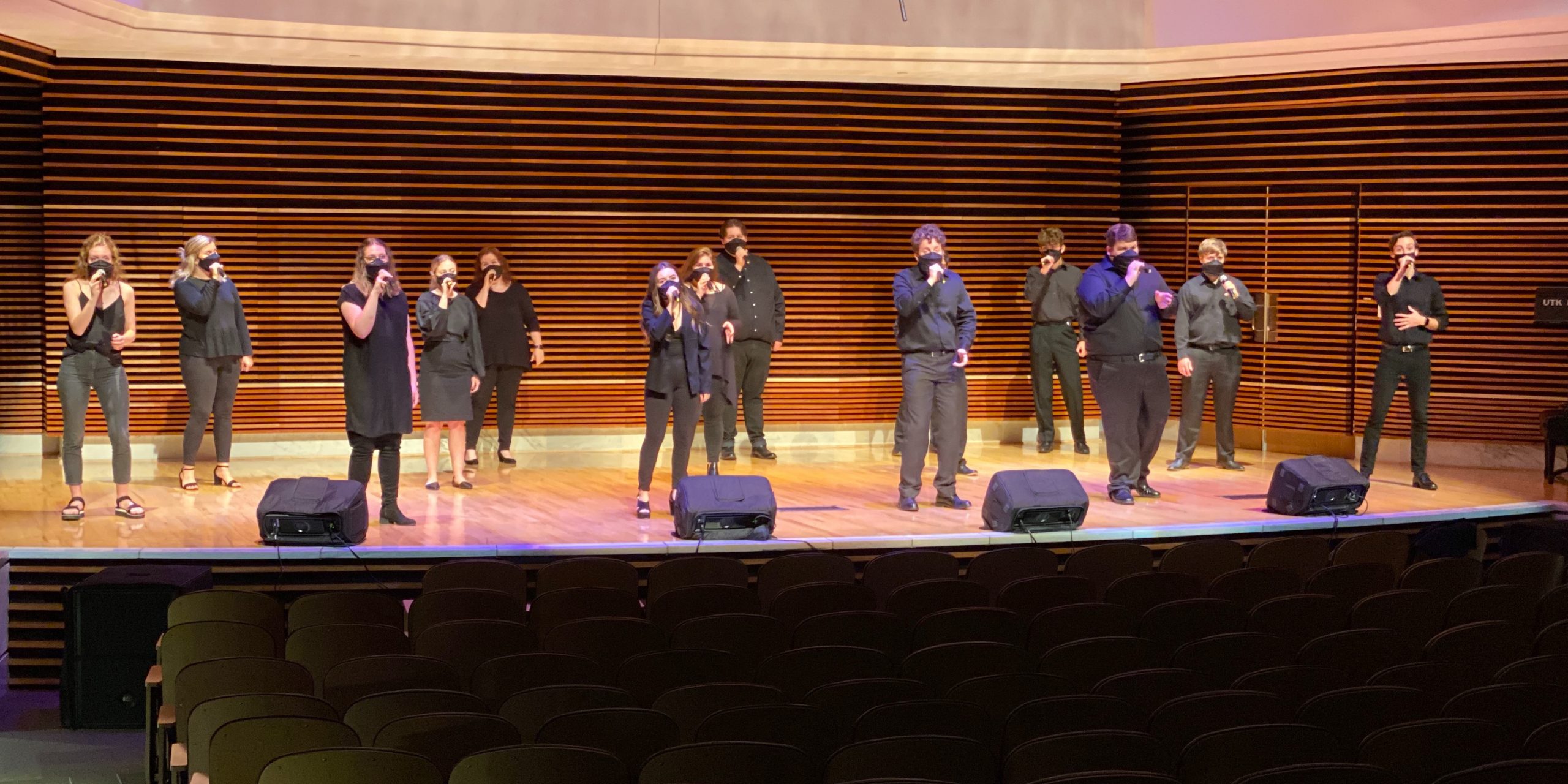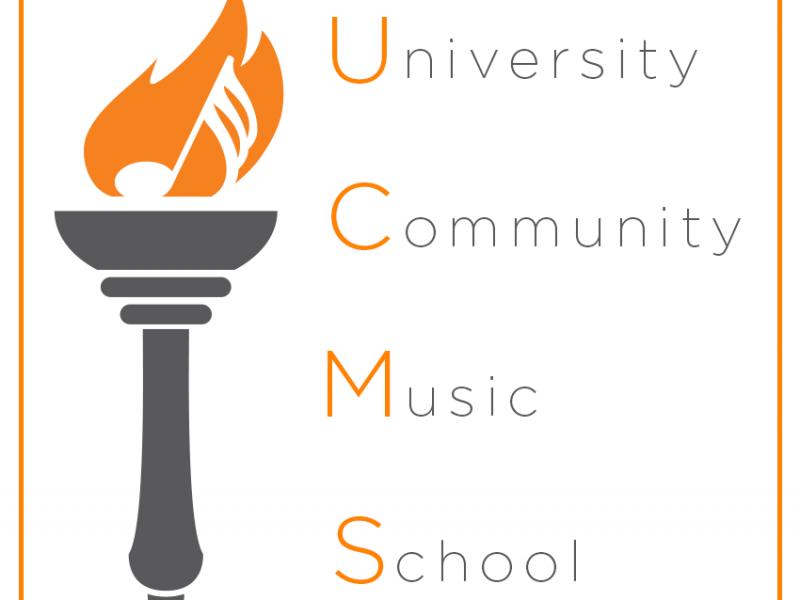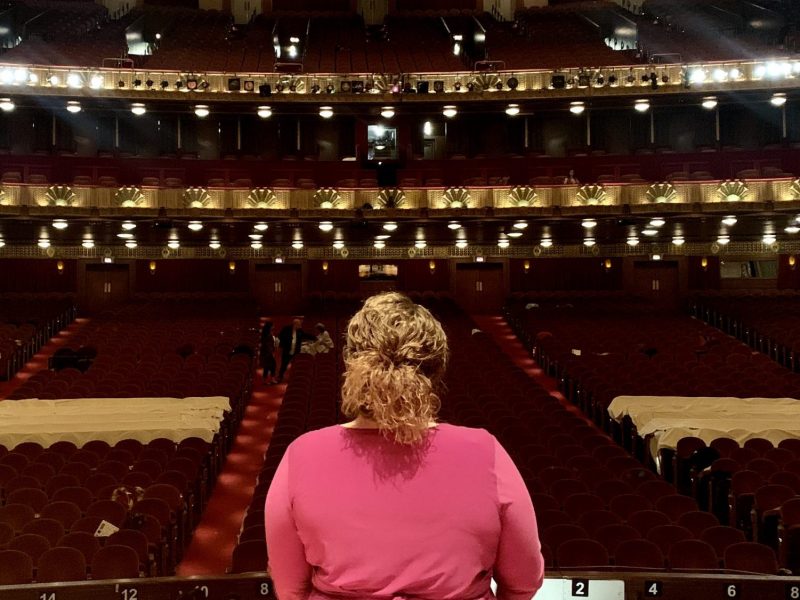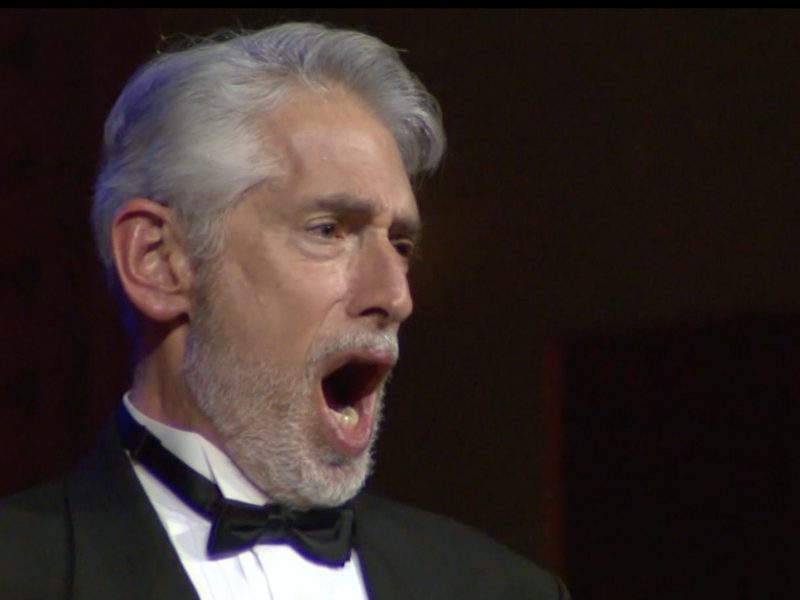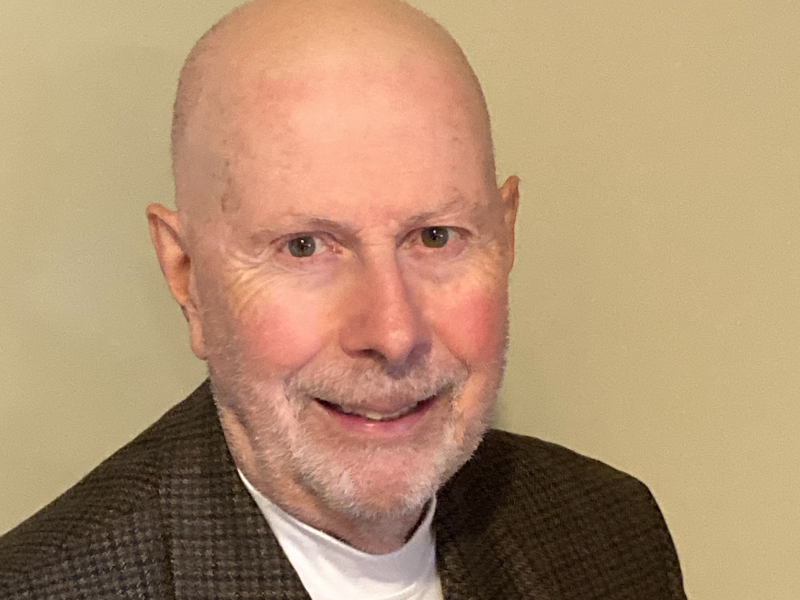How We Continue to Thrive
COVID-19 has presented many challenges since its emergence, but the School of Music continues to find creative ways to keep music alive and well in our community. The following includes some stories from the School of Music’s efforts during the pandemic.
Viola Students Perform for Senior Living Community
By Brian Canever
Four weeks into social distancing, music performance student Zach Miller felt close to his breaking point. Away from his campus routine, he spent most of the day alone or in online classrooms. His recitals and performances were canceled or switched to a digital submission format.
“I felt stripped of human interaction,” says Miller, a junior violin and viola student from Maryville, Tennessee.
Erin Parker, a senior music education major, was also struggling. One of her favorite classes included a hands-on jazz emphasis in the second half of the semester, and it wasn’t the same not being there in person to interact with her teacher and classmates.
The difficulties were obvious to Hillary Herndon, associate professor of viola at the School of Music. Through March and April, as the faculty worked with undergraduate and graduate students to plot a way forward when COVID-19 forced classes online, her students were finding themselves adjusting—many for the first time—to life conducted over Zoom.
“Music is a performance art; it’s not meant to be done by yourself in a room,” says Herndon. “To be able to interact with an audience, even if it’s thousands of miles away—that opportunity is very important for all musicians.”
“To be able to interact with an audience, even if it’s thousands of miles away—that opportunity is very important for all musicians.”
While listening to her Aunt Dottie recount a Zoom conversation she and other residents at a senior living community in Long Island, New York, had shared with a dog, Herndon hatched an idea.
“If they’re willing to spend time on Zoom with a dog they can’t pet, and I’ve got students who want to perform for somebody, maybe we could fill a need from both sides,” she thought. She emailed her viola studio students with three options for the juried performance that made up their final exam: a digital submission, a one-on-one performance for her over Zoom, or playing for the senior living community residents.
The plan came together on April 28 when five UT viola studio students performed over Zoom for Dottie and the other 13 residents of Jericho, New York’s Encore Luxury Living community. Beyond serving as the students’ final exam, the performance provided a social opportunity for people facing the isolation of COVID-19 in one of the country’s hardest-hit regions. And it was made possible only because of the willingness of Herndon and her students to learn and serve others at a time when many people are in dire need of connection.
Miller was second in the day’s lineup. He performed selections from Carl Stamitz’s Viola Concerto in D Major and Johann Sebastian Bach’s C Major Suite.
“I’m standing in my living room, and I’ve just finished playing and I’ve got applause coming through my laptop—that doesn’t happen in an academic setting,” Miller says.
Community engagement events and outreach to retirement communities, hospitals, and local schools are routine for faculty and students in the School of Music. In February, Herndon and other faculty members played for residents at Parkview Senior Living in Maryville.
“But this is the first time we’ve done something like this using technology,” Herndon says. “Because of that, it was the first time we were able to reach outside of our physical community. It was an opportunity to reach out and help by providing what we could do.”
The benefit was twofold: seniors had an opportunity to enjoy an afternoon of music, while students experienced an escape from feeling isolated. At the end of each student’s section, residents engaged and asked questions.
One resident asked Miller where he saw himself after finishing music school.
“They had a good idea of what we go through as musicians,” Miller says. “Getting to talk to each other made the interaction feel a little more human.”
For students who chose the group performance option, Herndon extended an invitation to their family and friends, who typically are permitted to attend only public recitals.
“It really touched my heart to have my family there, especially during this time when we’re all feeling disconnected,” says Parker, who lives in Maryville and hasn’t seen her mom or stepdad—who attended the Zoom call along with her sister, niece, and nephew—since social distancing started. Parker performed Mark Summers’s “Julio-O” and Bach’s Viola da Gamba Sonata in G major.
Behind the scenes, Herndon had worked with Shayla Superior, social director for Encore Luxury Living, to organize the performance. She created a program, as she would for any recital, while Superior created a poster and promoted the event to the center’s 14 residents, who all attended.
“Residents are really confined to their rooms right now,” Superior says. “They aren’t able to enjoy their lives as they once were.”
As COVID-19 intensified, community administrators canceled all trips and temporarily closed the dining halls. Residents, who must wear masks at all times and are not permitted to have visitors inside the building, have meals delivered to their rooms and rely on drivers and staff to pick up prescriptions and groceries. Nassau County, where the community is located, has experienced nearly 40,000 confirmed coronavirus cases and more than 2,000 deaths (as of May 2020).
Although the performance wasn’t without its complications—Superior had to find the right speakers, a setting accessible for Wi-Fi, and a screen to project the performance on—she couldn’t help smiling behind her mask as the students played.
“It was a wonderful afternoon,” says Superior, who had hors d’oeuvres for residents to enjoy during the performance. “They love classical music. There was a sense of community, even though they understood it’s not our community here in New York.”
The performance was Superior’s first experiment organizing an activity over Zoom. But its success has led her to plan virtual yoga, cooking, cocktail creation classes, and hopefully additional musical performances in the future.
Parker, who is currently seeking out student teaching opportunities and plans to start an event ensemble, has been inspired to organize her own Zoom concerts for family and friends she hasn’t seen in months.
Miller sees the virtual concert as an extension of the spirit he experienced on campus.
“There are conservatories across the US that are filled with incredibly talented people. But UT—we’re still here. We have this really special aura,” he says. “Being able to share the Volunteer spirit with somebody outside of Tennessee, outside of the Southeast—I never thought I’d be able to share what I do with people this way.”
This summer he has been invited to train with both a viola professor at Vanderbilt University’s Blair School of Music and the principal violist at the Nashville Symphony, using Zoom and online learning tools.
Herndon hopes to incorporate more virtual activities in future semesters for her students. Virtual performances may not substitute for a live performance in front of a crowd, but they demonstrate a creative way forward in a time when audiences are unable to gather.
“It’s just like interacting over Zoom isn’t the same as being in the same room together,” Herndon says. “But knowing what we know now, we see what is possible.”
COVID-19: A Perspective for the Arts & Humanities
By Brian Canever
Nathan Fleshner, assistant professor of music theory and composition, wrote the following article for The Polyphony (March 18, 2020) regarding the challenges and the opportunities for the arts and humanities field.
The world is reeling from the shock of the proliferation of the SARS-CoV-2 virus that leads to Coronavirus Disease 2019, better known as COVID-19. As we remove ourselves from social situations and even eliminate interpersonal interactions altogether in an effort to slow the spread of infection, we are entering a new period of fear and uncertainty that threatens the stability of our health, financial, social, and education systems as well as our emotional and physical well-beings. To complicate matters, misinformation abounds. There has been a rise in misinformation, resulting in conflicting and confusing perspectives, fostered by new cultural terminology like “fake news” and “alternative facts.” In such a time as this, facts are critical. Without facts on which to solidify confidences in our ability to overcome this viral onslaught on our world’s health and stability, fear abounds.
Fear is a dangerous commodity. One of its primary sources is the unknown. We don’t know enough about how the virus is transmitted. We don’t know enough about the symptoms of the disease. We don’t know enough about the treatment of the disease. We are worried about our and our loved ones’ psychological and physical well-beings. We don’t know what the future holds. For those of us who teach in the arts and humanities and for all educators, we don’t know exactly how the remainder of our teaching will be delivered and when we will be able to return to our face-to-face classrooms. We know for the time being, instruction will be almost exclusively online, but many have not taught in this format before, so yet another unknown presents itself.
An Opportunity for the Arts, Humanities, and Sciences
Like most universities across the United States. and abroad, my school has transitioned to fully online instruction for the remainder of the semester. As I walked out of the building on my last day of face-to-face instruction, I heard several groups of students discussing the virus and their uncertainty as to their safety and how the remainder of their semester might unfold. In a similar state of uncertainty, my colleagues across the United States and I turn our thoughts toward transferring the remainder of our courses to an online format—a task that many of us have never considered and some have even considered a threat to their own positions as instructors. This will no doubt be a burden for many, but I see it also as a tremendous opportunity. I’m grateful that our semesters were not fully cut short, but have the possibility of continuing through various guises of online delivery. The important thing to me is that I will still have contact with my students and thus an opportunity and an important role in helping them through this time. The remainder of this essay expounds the reasons I see this as so important.
My research and teaching specialty is music theory. I have had several crises of confidence in my career choice and its importance to the world and humankind. I have pondered my wife’s career as a nurse; friends who are medical doctors, mathematicians, and linguists who maintain our most basic skills to communicate and compute within and about our world; scientists studying biology, chemistry, and physics; along with virologists and epidemiologists who may be ultimately responsible for the protection of life on this planet. Art, music, and the humanities are important, too—arguments for which abound and are beyond my focus here. To be clear, I’m quite certain of the importance of the practice and instruction of the arts and humanities. Suffice it to admit, however, that I have sometimes struggled with my own understanding of my profession’s importance in the world.
I have overcome these crises of confidence, concluding that what I truly teach is thinking and logic and coming to the realization that, while I certainly want my students to learn about music and its organization, what I really want them to gain in my classes is a sense of how to observe data and its relationship with other data and create well-formed, logical interpretations of that data. Like our sister disciplines of the visual, theatrical, and literary arts, music, as an art, requires a certain amount of subjective interpretation, a common thread throughout much of the humanities. And music theory is no stranger to this subjectivity. The analysis of a musical composition involves an act of creativity and interpretation. One examines a piece of music—either visually or aurally, observes its musical components, formulates an interpretation of how those musical components are structured both individually and in coordination with other musical components in the piece, and repackages that in a narrative that is logical, cohesive, and understandable (and therefore useful) to other musicians.
While this activity is certainly subjective, there are strong threads of objectivity that must be present in any interpretation of music. There are no “alternative facts” in music theory. There are factual elements on which we can and must ground our interpretations. We cannot say, for example, that a note is a C, when it is actually a C sharp. As data points accumulate, however, things begin to become murkier. We have to weigh information with new information encountered in a piece. We reinterpret old data in light of that new information. As we look at a musical composition, the pitch, C, might seem important, but then we encounter an A and reconsider the original C as perhaps connected to this A as a single unit, perhaps creating part of an A-minor triad. But a third data point, the pitch F, might enter the picture, and it is only now that we understand that original C to be the top part of an F major triad. Mahler’s famous Adagietto, the fourth movement of his Fifth Symphony, opens in exactly this way, with these exact notes. It’s not until the third measure before we finally get the F, the root of the chord, and know exactly where we are tonally in the movement. I’ve used this as an example of this kind of music analysis, but also because it is one of my favorite moments of peace in the musical literature. I highly recommend listening. You’ll hear C’s and A’s sustained in the strings and arpeggiated downward in the harp. It’s not until the downbeat of the third measure where the double basses and harp pluck the F that grounds the opening harmony, and we finally feel aurally home. You can hear the cellos descending and the first violins ascending toward this F during this opening—all leading toward that third measure where the melody truly gets going in the first violins. It’s a beautiful moment of tension and then peace. May it bring you peace as well.
That’s an example of the kind of observational thinking I aim to teach in my discipline, but every subject in the arts, humanities, and sciences alike could likely come up with a parallel disciplinary example. Students with this kind of experience in thinking have a powerful tool to use as they process the daily updates and new information about COVID-19. In this period of rapidly changing data, our students are bombarded by seemingly endless information, much of which is labeled as or assumed to be factual information. They are confronted with a sea of armchair epidemiologists and an even larger sea of information spewing from many sources, some traditionally trustworthy, only to have it contradicted and/or corrected right after. They have to assemble multiple observations and test them against one another to solidify them into strong, well-formed analyses. And they must be vigilant to make sure that information comes from reliable sources based on factual observations.
“Students with this kind of experience in thinking have a powerful tool to use as they process the daily updates and new information about COVID-19.”
This story has been repurposed from the original publisher, The Polyphony. This story was originally published on March 18, 2020.
